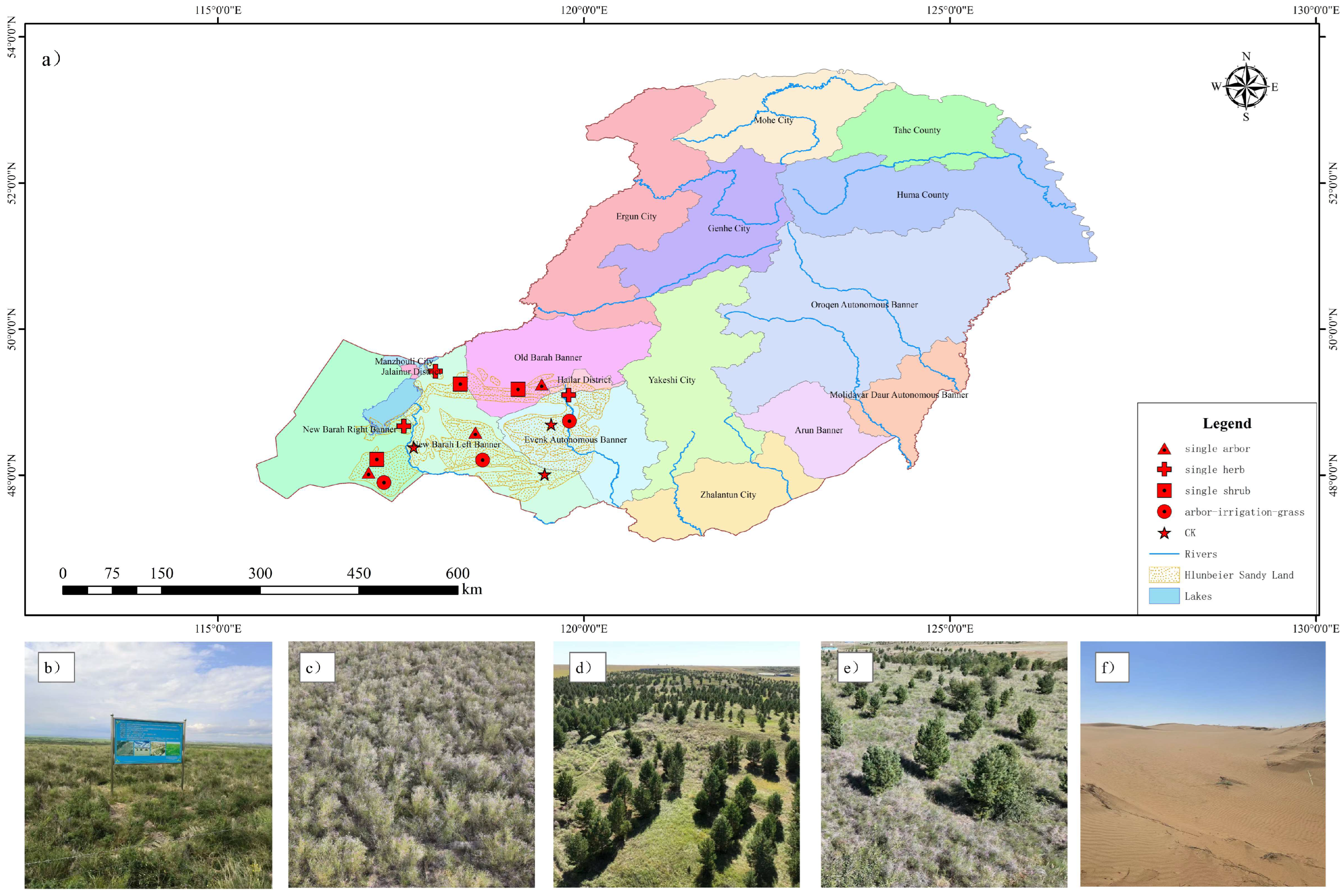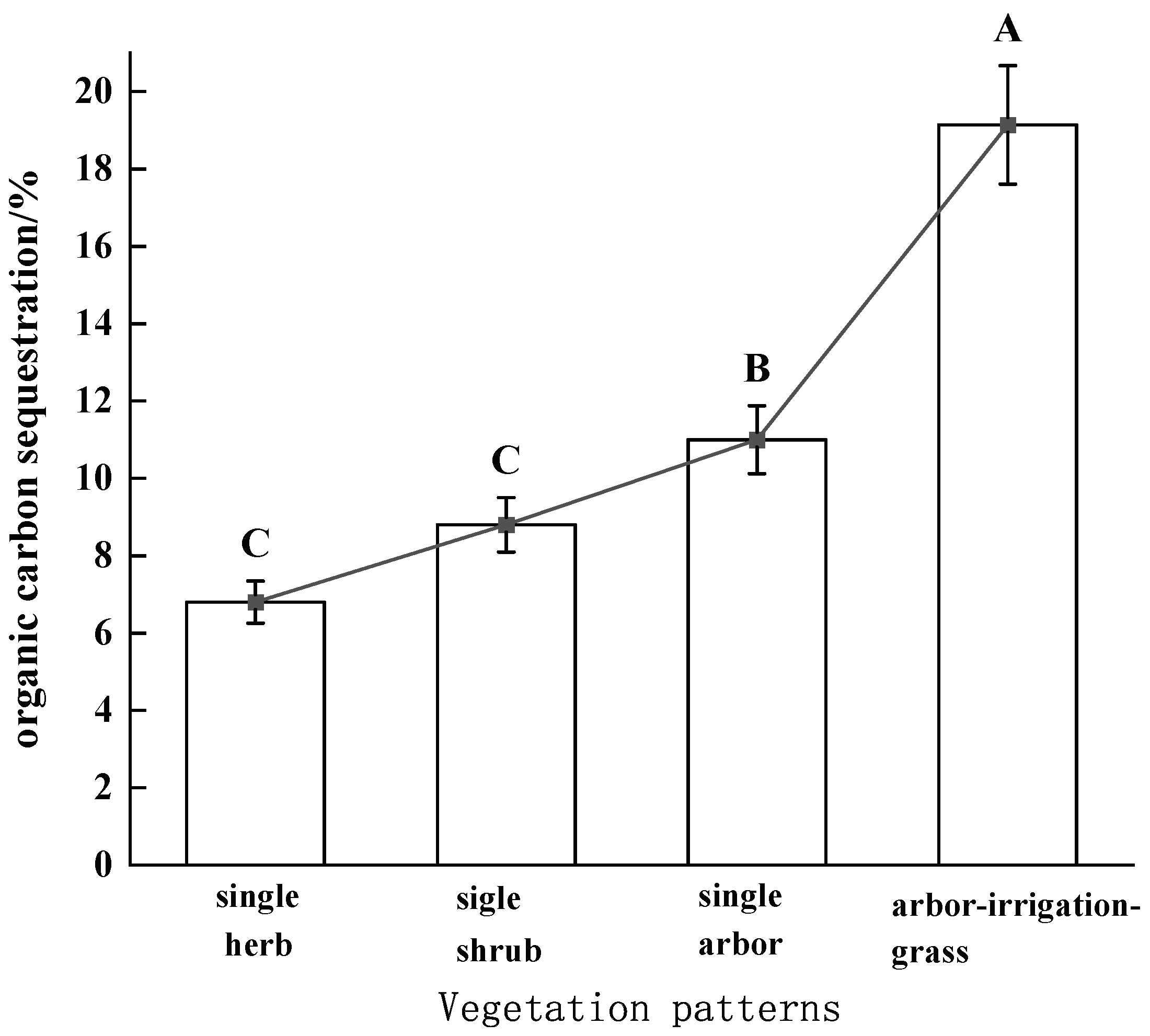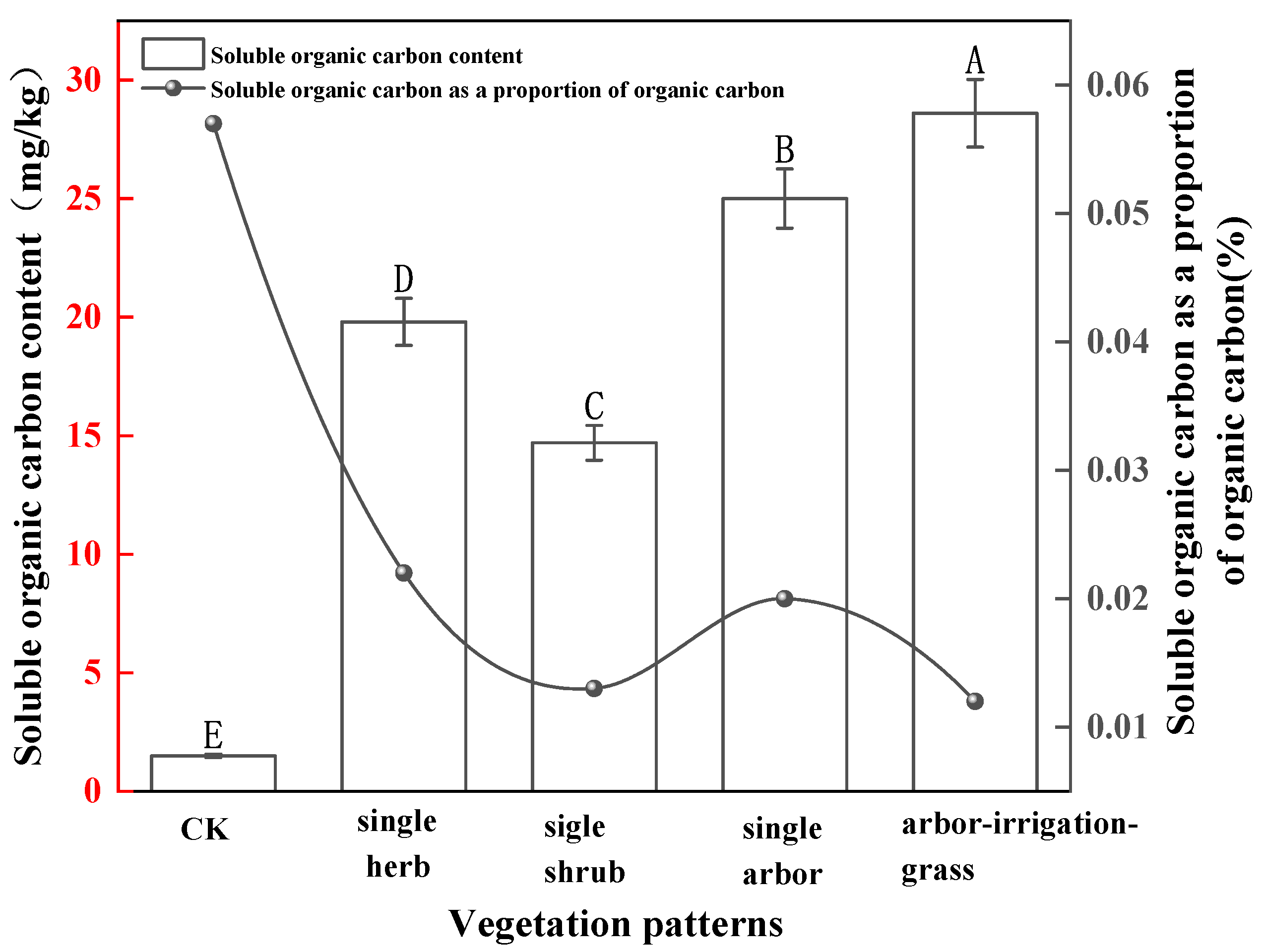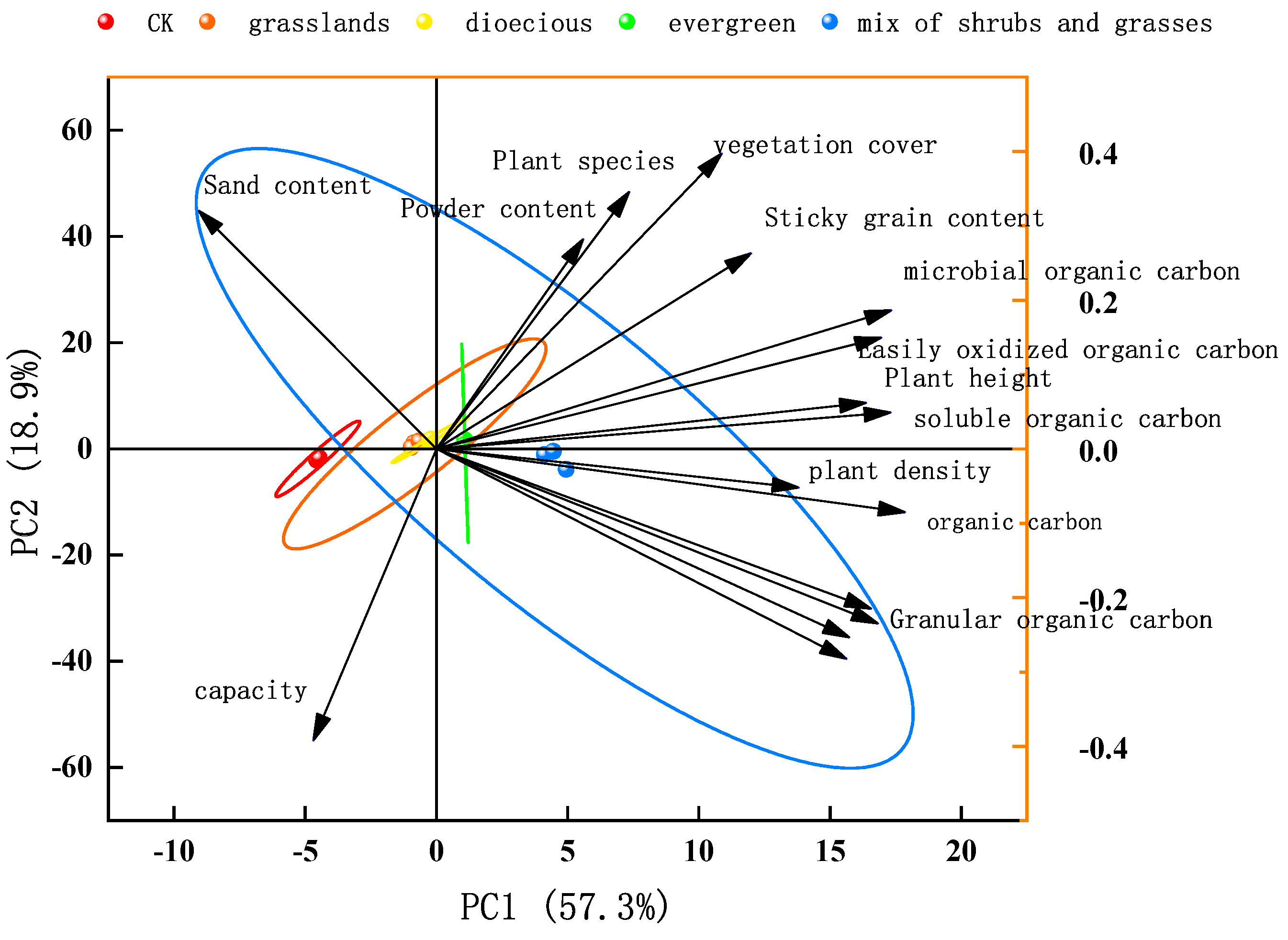Effects of Different Vegetation Management Measures on Soil Organic Carbon Fractions in Hulunbeier Sandy Land
Abstract
1. Introduction
2. Materials and Methods
2.1. Overview of the Study Area
2.2. Research Methods
2.2.1. Test Sample Collection
2.2.2. Sample Determination
2.2.3. Calculation of Indicators
2.2.4. Symbol List
2.2.5. Data Processing
3. Results and Analysis
3.1. Differences in Surface Soil Organic Carbon Content of Different Artificial Vegetation Patterns
3.2. Differences in Surface Soil Organic Carbon Fractions in Different Artificial Vegetation Patterns
3.2.1. Differences in Soil Particulate Organic Carbon
3.2.2. Differences in Soil Microbial Organic Carbon
3.2.3. Differences in Soil-Soluble Organic Carbon
3.2.4. Differences in Soil Easily Oxidized Organic Carbon
3.3. Effects of Soil Physical and Chemical Properties on Organic Carbon and Its Components
4. Discussion
4.1. Effects of Different Artificial Vegetation Patterns on Surface Soil Organic Carbon Content
4.2. Effects of Different Artificial Vegetation Patterns on Surface Soil Organic Carbon Fractions
4.3. Soil Organic Carbon Impact Factors of Different Artificial Vegetation
5. Conclusions
Author Contributions
Funding
Data Availability Statement
Acknowledgments
Conflicts of Interest
References
- Lu, Q.; Lei, J.Q.; Li, X.S.; Yang, Y.L.; Wang, F. China’s Combating Desertification: National Solutions and Global. Paradigm. Bull. Chin. Acad. Sci. J. 2020, 35, 656–664. [Google Scholar]
- Tang, L.C.X.; Yang, J.; Zhu, Q.L. Study on Environmental Problems and Countermeasures of Land Desertification in China. Heilongjiang Environ. J. 2022, 35, 97–99. [Google Scholar]
- Wang, S.H.; Wang, Y.W.; Wang, Y.S.; Wang, Y.J.; Chen, A.H.; Wang, S.F. An analysis of the causes, hazards and management countermeasures of land desertification. China Society for Sand Control and Sand Industry. In Proceedings of the 2018 Annual Academic Conference of China Society for Sand Control and Sand Industry, Qinghai, China, 10 August 2018. [Google Scholar]
- Deng, L.; Liu, Y.L.; Li, J.W.; Shangguan, Z.P. Effect of Vegetation Restoration on Soil Carbon Sequestration: Dynamics and Its Driving Mechanisms. J. Soil Water Conserv. J. 2023, 37, 1–10. [Google Scholar]
- Hu, Q.Y.; Liu, T.Q.; Ding, H.N.; Li, C.; Yu, M.; Liu, J.; Cao, C. The effects of straw returning and nitrogen fertilizer application on soil labile organic carbon fractions and carbon pool management index in a rice-wheat rotation system. Pedobiol. Sci. 2023, 101, 150913. [Google Scholar] [CrossRef]
- Guo, W.F.; Chen, Y.M.; Gao, F.; Wang, J.L. Traits of seven medicinal plants in Taihang Mountains and their responses to soil factors. J. Environ. Eng. J. 2024, 14, 612–621. [Google Scholar]
- Sun, T.; Feng, X.M.; Gao, X.H.; Deng, A.X.; Zhang, C.Y.; Song, Z.W.; Zhang, W.J. Effects of Diversified Cropping on the Soil Aggregate Composition and Organic Carbon and Total Nitrogen Content. Sci. Agric. Sin. J. 2023, 56, 2929–2940. [Google Scholar]
- Zhang, X.F.; Zheng, S.M.; Xia, Y.H.; Hu, Y.J.; Su, Y.R.; Chen, X.B. Responses of Soil Organic Carbon Fractions to Land Use Types in Hilly Red Soil Regions, China. Environ. Sci. J. 2020, 41, 1466–1473. [Google Scholar]
- Zhang, S.L.; Sheng, M.Y.; Wang, L.J.; He, X.X.; Luo, N.N. Effects of long-term vegetation restorations on soil organic carbon fractions in the karst rocky desertification ecosystem, Southwest China. Acta Ecol. Sin. J. 2023, 43, 8476. [Google Scholar]
- Yang, M.; Zhang, L.M.; Wu, Y.N.; Yuan, D.M.; Yu, L.F. Changes of Carbon Content in Litter During Plant Community Restoration in Maolan National Nature Reserve. J. Mt. Agric. Biol. J. 2022, 41, 28. [Google Scholar]
- Zhao, F.Z. Regulation Mechanism of Carbon Sequestration by C: N:P Stoichiometry in Soil Under Conversion of Cropland to Forest in Loess Hilly Region; Northwest Agriculture and Forestry University: Yangling, China, 2015; Volume 78. [Google Scholar]
- Sun, Z.C.; Qin, W.L.; Wang, X.; Zhang, Y.; Li, G.; Wang, Z. Effects of manure on topsoil and subsoil organic carbon depend on irrigation regimes in a 9-year wheat-maize rotation. Soil Tillage Res. 2021, 205, 104790. [Google Scholar] [CrossRef]
- Wu, H.Q.; Du, S.Y.; Zhang, Y.L.; An, J.; Zou, H.; Yu, N. Effects of irrigation and nitrogen fertilization on greenhouse soil organic nitrogen fractions and soil-soluble nitrogen pools. Agric. Water Manag. 2019, 216, 415–424. [Google Scholar] [CrossRef]
- Hao, H.B.; Xu, W.X.; Hou, Z.A. Effects of coupled water and nitrogen on soil organic carbon fractions and enzymes in a drip-irrigated cotton field. J. Plant Nutr. Fertil. 2023, 29, 860–875. [Google Scholar]
- Yang, H.; Peng, X.Y.; Yang, S.Q.; Zhang, Y.B.; Zhao, C.; Huang, Y. Effects of land use types on soil organic carbon and soil labile organic carbon in karst-faulted basin of southern Yunnan. Acta Ecol. Sin. 2022, 42, 7105–7117. [Google Scholar]
- Yang, L.X.; Pan, J.J. Progress in the Study of Measurements of Soil Active Organic Carbon Pool. Chin. J. Soil Sci. 2004, 35, 502–506. [Google Scholar]
- Xu, G.P.; Li, Y.Q.; Shen, Y.Y.; Zhang, D.N.; Sun, Y.J.; Zhang, Z.F.; Zhou, L.W.; Duan, C.Y. Soil Organic Carbon Distribution and Components in Different Plant Communities Along a Water Table Gradient in the Huixian Karst Wetland in Guilin. Environ. Sci. 2019, 40, 1491–1503. [Google Scholar]
- Lao, H.B.; Liu, F.; Liu, Y.S.; He, T.B.; Su, Y.G. Variation of Forest Soil Organic Carbon in Karst Rocky Desertification Area. Sci. Silvae Sin. 2009, 45, 24–28. [Google Scholar]
- Chen, W.; Yang, J.J.; Yuan, Y.; Zhang, H.; Han, P.F. Effects of artificial sand-fixing vegetation on soil nutrients in Mu Us Sandy Land. Arid Zone Res. 2020, 37, 1447–1456. [Google Scholar]
- Jiang, L.J.; Ma, J.; Liu, J.K.; Wang, S.; Zhao, J.; Bai, J. Spatial Distribution of Soil Physicochemical Properties Under Different Vegetation Restoration Measures in Mu Us Sand Land. Bull. Soil Water Conserv. 2022, 42, 1–7. [Google Scholar]
- Dong, L.; Li, J.; Liu, Y. Forcstation delivers significantly more olfactive results in soil C and Nscqucstrations than natural succession on badly degraded arcas: Evidence from thc CentralLoess Plateau case. Catena 2022, 208, 105734. [Google Scholar] [CrossRef]
- Wang, Z.Q.; Du, L.L.; Zhao, M.; Guo, S.L. Differences in soil organic carbon and total nitrogen and their impact factors under different restoration patterns in the Loess Plateau. Chin. J. Appl. Ecol. 2016, 27, 716–722. [Google Scholar]
- Xi, P.; Dong, Q.; Zhang, Y.N.; Li, X.; Xia, W.W.; Xu, C.; Liu, M.S. Distribution characteristics of active components in soil organic carbon across typical plant communities in Yancheng coastal wetlands. Chin. J. Appl. Ecol. 2020, 39, 3623–3632. [Google Scholar]
- Cambardella, C.A.; Eliot, E.T. Particulate soil organic matter changes across a grassland cultivation sequence. Soil Sci. Soc. Am. J. 1992, 56, 777–783. [Google Scholar] [CrossRef]
- Li, L.J.; Han, X.Z. Changes of soil properties and carbon fractions after long-term application of organic amendments in Mollisols. Catena 2016, 143, 140–144. [Google Scholar] [CrossRef]
- Xie, F.; Han, X.R.; Yang, J.F.; Zhan, X.M.; Tang, L. The Effect on the Contents of SMBC and WSOC under Long-term Fertilization on Brown Soil. Agric. Sci. Technol. Equip. 2008, 10–13. [Google Scholar]
- Lefroy, R.D.B.; Blair, G.J.; Strong, W.M. Changes in soil organic matter with cropping as measured by organic carbon fractions and 13C natural isotope abundance. Plant Soil 1993, 155–156, 399–402. [Google Scholar] [CrossRef]
- Bao, S. Soil Agrochemical Analysis, 3rd ed.; China Agricultural Press: Beijing, China, 2000. [Google Scholar]
- Ding, Y.G.; Yang, J.; Song, B.Y.; Hugejiletu, Z.L. Effect of different vegetation types on soil organic carbon in Mu Us desert. Acta Prataculturae Sin. 2012, 21, 18–25. [Google Scholar]
- Wang, D.; Geng, Z.C.; She, D.; He, W.X.; Hou, L. Soil organic carbon storage and vertical distribution of carbon and nitrogen across different forest types in the Qinling Mountains. Acta Ecol. Sin. 2015, 35, 5421–5429. [Google Scholar]
- Feng, Q.; Yang, L.; Wang, J.; Shi, X.Y.; Wang, Y.F. Response of soil moisture and soil organic carbon to vegetation restoration in deep soil profiles in Loess Hilly Region. Acta Ecol. Sin. 2019, 39, 6598–6609. [Google Scholar]
- Li, B.B.; Li, P.P.; Yang, X.; Xiao, H.; Xu, M.; Liu, G. Land-use conversion changes deep soil organic carbon stock in the Chinese Loess Plateau. Land Degrad. Dev. 2020, 32, 505–517. [Google Scholar] [CrossRef]
- Li, F.; Li, J.; Long, J.; Liao, H.K.; Liu, L.F.; Zhang, W.J. Effect of vegetation types on soil organic carbon and nitrogen in typical karst mountainous area. Chin. J. Appl. Ecol. 2015, 34, 3374–3381. [Google Scholar]
- Jiang, S.X.; Zhao, P.; Zhang, J.N.; Li, D.L.; Liu, Z.X. Characteristics and Influencing Factors of Soil Organic Carbon in Typical Vegetation in the Qilian Mountains. For. Grassl. Resour. Res. 2024, 1–7. [Google Scholar] [CrossRef]
- Zhang, W.H.; Zha, X.H.; Yi, H.Y. Changes of Soil Organic Carbon Content under Different Vegetation Types. Hubei Agric. 2015, 54, 2594–2598. [Google Scholar]
- Liang, X.Y.; Xin, B.Z.; Liu, S.B.; Shen, H.Y. The Coupling Interaction of Soil Organic Carbon and Soil Water of Vegetation Restoration in Bashang Area of Hebei. J. Soil Water Conserv. 2022, 36, 206–212. [Google Scholar]
- Wang, D.F.; Dong, L.B.; Li, A.; Yu, Z.J.; Deng, L. Soil Organic Carbon and Moisture Effects of Different Vegetation Restoration Types in the Mu Us Sandy Land. J. Soil Water Conserv. 2024, 38, 101–110+120. [Google Scholar]
- Zhang, Z.Y.; Wang, Y.; Ai, N.; Liu, G.Q.; Liu, C.H. Distribution characteristics of soil organic carbon and its influencing factors in different vegetation types in the loess region of northern Shaanxi Province, northwestern China. J. Beijing For. Univ. 2020, 42, 56–63. [Google Scholar]
- Yu, R.; Wang, Q.C.; Zhu, P.; Liu, Q.; Wang, H.; Sun, C.Y. Effect of Long-term Fertilization on Aggregate and Fractions of Organic Carbon in Black Soil. Chin. J. Soil Sci. 2013, 44, 594–600. [Google Scholar]
- Xu, S. Characteristics of Soil Organic Carbon Pool Composition and Sources under Different Vegetation Types in Hongliulin Coal Mine; Northwest Agriculture and Forestry University: Yangling, China, 2024. [Google Scholar]
- Zhang, X. Effects of Different Farmland Management Practices on Soil Organic Carbon Pools and Stabilization Mechanisms in the Weibei Dry Loess Plateau; Northwest Agriculture and Forestry University: Yangling, China, 2022. [Google Scholar]
- Wang, G.B.; Zhao, X.L.; Wang, M.H.; Ruan, H.H.; Xu, C.B.; Xu, Y.M. Effects of land use change on soil readily oxidizable carbon in a coastal area of northern Jiangsu Province, East China. Chin. J. Appl. Ecol. 2013, 24, 921–926. [Google Scholar]
- Hu, Y.S.; Yao, X.Y.; Liu, Y.H. N and P stoichiometric traits of plant and soil in different forest succession stages in Changbai Mountains. Chin. J. Appl. Ecol. 2014, 25, 632–638. [Google Scholar]
- Cao, X.Y.; Li, J.P.; Zhang, C.C.; Fang, X.N.; Xie, X.Y. Variation of Contents of Organic Carbon and Physic-chemical Properties of Soil and Path Analysis for Their Relations in Different Age-group Chinese Fir Plantations. J. Soil Water Conserv. 2014, 28, 200–205. [Google Scholar]
- Zhang, Z.T.; Wang, J.M.; Li, B. Determining the influence factors of soil organic carbon stock in opencast coal-mine dumps based on complex network theory. Catena 2019, 173, 433–444. [Google Scholar] [CrossRef]










| Sample Plot Type | A | B | C | D | CK |
|---|---|---|---|---|---|
| Type of measure | Sowing Goat Weed | Sowing poplar firewood | Planting Cinnamon Pine | Planting of sphagnum pine, combined with sowing of poplar firewood, sheep grasses | No measures |
| Mode | single herb | single shrub | single arbor | arbor–irrigation–grass | - |
| Years of restoration/year | 5.7 | 6 | 5.4 | 5 | - |
| Number of plant species/species | 11 | 6 | 10 | 6 | 0 |
| Soil capacity/g·m2 | 1.65 | 1.6 | 1.54 | 1.64 | 1.68 |
| Sticky particles/% | 3.9 | 5.2 | 4.2 | 4.6 | 2.8 |
| Powder grain/% | 2.5 | 5.3 | 1.8 | 3 | 1.3 |
| Sandy grain/% | 93.6 | 89.5 | 94 | 92.4 | 95.9 |
| pH | 6.8 | 7.3 | 7.4 | 7.0 | 7.7 |
| Soil adsorption capacity/cmol+·kg−1 | 1.7 | 2.0 | 2.4 | 2.9 | 1.1 |
| Hydrolyzed acidity /cmol·kg−1 | 25.1 | 29.8 | 33.5 | 37.2 | 20.9 |
| Water content/% | 7.14 | 6.13 | 6.61 | 7.51 | 3.37 |
| Dominant species | Sheepshead, Artemisia, Thyme, Commiphora | Yang Chai | Sphagnum pine, conifer | Sphagnum pine, tussock grass, fescue, poplar firewood | Sarpent-ine, Worm-wood |
| Vegetation height/cm | 31 | 38.4 | 84.48 | 81.5 | |
| Planting density/m2 | 145 | 10 | 113 | 175 | |
| Vegetation cover/% | 75 | 75 | 55 | 60 | ≤10 |
| Symbol | Significance | Symbol | Significance |
|---|---|---|---|
| POC | Particulate Organic Carbon | TC | Total Carbon |
| MBC | Microbial Organic Carbon | TN | Total Nitrogen |
| DOC | Soluble Organic Carbon | TP | Total Phosphorus |
| EOC | Easily Oxidized Organic Carbon |
Disclaimer/Publisher’s Note: The statements, opinions and data contained in all publications are solely those of the individual author(s) and contributor(s) and not of MDPI and/or the editor(s). MDPI and/or the editor(s) disclaim responsibility for any injury to people or property resulting from any ideas, methods, instructions or products referred to in the content. |
© 2025 by the authors. Licensee MDPI, Basel, Switzerland. This article is an open access article distributed under the terms and conditions of the Creative Commons Attribution (CC BY) license (https://creativecommons.org/licenses/by/4.0/).
Share and Cite
Liu, Y.; Yuan, L.; Dang, X.; Meng, Z.; Zhao, Y. Effects of Different Vegetation Management Measures on Soil Organic Carbon Fractions in Hulunbeier Sandy Land. Forests 2025, 16, 727. https://doi.org/10.3390/f16050727
Liu Y, Yuan L, Dang X, Meng Z, Zhao Y. Effects of Different Vegetation Management Measures on Soil Organic Carbon Fractions in Hulunbeier Sandy Land. Forests. 2025; 16(5):727. https://doi.org/10.3390/f16050727
Chicago/Turabian StyleLiu, Yue, Limin Yuan, Xiaohong Dang, Zhongju Meng, and Yang Zhao. 2025. "Effects of Different Vegetation Management Measures on Soil Organic Carbon Fractions in Hulunbeier Sandy Land" Forests 16, no. 5: 727. https://doi.org/10.3390/f16050727
APA StyleLiu, Y., Yuan, L., Dang, X., Meng, Z., & Zhao, Y. (2025). Effects of Different Vegetation Management Measures on Soil Organic Carbon Fractions in Hulunbeier Sandy Land. Forests, 16(5), 727. https://doi.org/10.3390/f16050727






